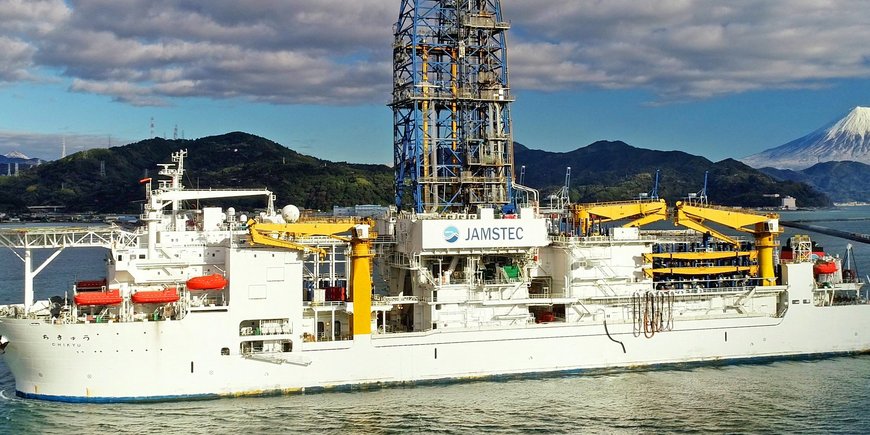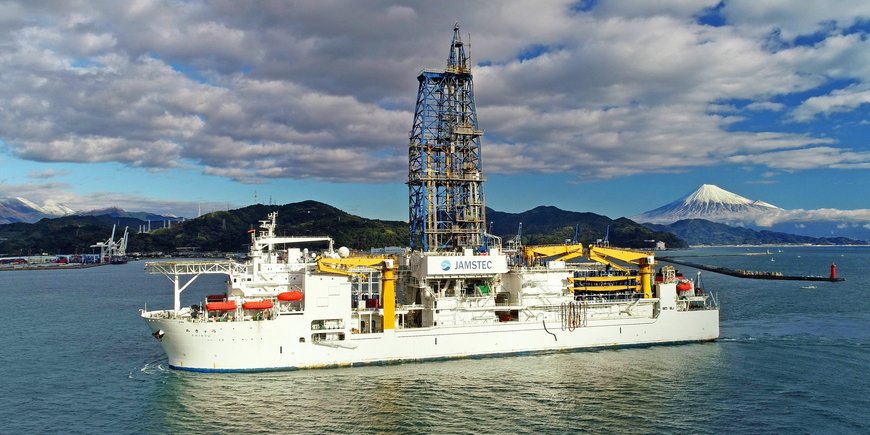Microbes colonise the seabed to a depth of several kilometres. This has only been known for about thirty years. However, it is true that the deeper the warmer. Therefore, the question arises as to the temperature limit at which life is still possible. This has been investigated by a large international research team, led by MARUM - Centre for Marine Environmental Sciences at the University of Bremen and the Japan Agency for Marine-Earth Science and Technology (JAMSTEC) - with the participation of Jens Kallmeyer from the German Research Centre for Geosciences in Potsdam GFZ. The drilling expedition off Japan showed that active bacteria can still be found even in zones with a temperature of 120 degrees Celsius. The results of the study were published today in Science Magazine.
It is known that some particularly heat-loving microorganisms can exist at temperatures of up to 80 degrees Celsius. Archaea, for example, can tolerate even higher temperatures - in the laboratory they survived 122 degrees Celsius for a short time. But what is the long-term effect of such heat on these creatures? In order to research this, we need access to their habitats. For scientists, this is only possible with the Deep-Sea Scientific Drilling Vessel Chikyu. The Nankai Trough off Japan offers particularly favourable conditions for such drilling: There, 120-degree hot habitats can be reached not just 4,000 metres below the seabed, but already at 1,180 metres, though at a water depth of 4,800 metres. The expedition took place as part of the International Ocean Drilling Program (IODP) in 2016.
Astonishing Results
The main findings: To the astonishment of the researchers, the concentration of vegetative cells, i.e. micro-organisms that actively carry out metabolism, collapsed above 45 degrees Celsius by two orders of magnitude to less than 100 cells per cubic centimetre. In sediment with a temperature of between 75 and 95 degrees Celsius, the number of endospores - cells of certain types of bacteria that switch to a dormant mode to survive conditions that are unfavourable for them - rose rapidly to around 120,000 spores per cubic centimetre.
Even at 120 degrees Celsius, there were still cells that are alive and metabolically active. They convert acetate, a common bacterial nutrient to methane albeit at an extremely low rate. Only by using sophisticated methods it was possible to determine these very faint signals of life. Investigations in higher temperature ranges were not possible due to the geological conditions on site, because the sediment layer did not reach deeper.
"We were particularly surprised by the fact that above 45 degrees Celsius, populated zones alternate with layers where no life could be detected at all. The latter could be around 200 metres thick. It might not mean that they are absolutely devoid of life, but there must be less than 16 microbial cells per cubic centimeter. At greater depths and at higher temperatures we were then able to find microorganisms again," says Jens Kallmeyer. The researchers suspect that these relatively lifeless zones were caused by the fact that all life was extinguished here during the sediment development due to short-term exposure to extremely high temperatures.
High-precision Analysis
Jens Kallmeyer heads the Laboratory for Aquatic Geochemistry and the Radioisotope Laboratory in the GFZ Geomicrobiology Section. He did not accompany the expedition on board, but was part of the large international team which, with its respective expertise, planned and carried out the many highly specialised experiments to analyse the drilling samples obtained and evaluated the results.
Kallmeyer's speciality is the detection of microbial activity using radioactive markers. So far, even the most sensitive molecular biological methods failed in these sediments because the number of microbes is far too small. Instead, they are fed with radioactively labelled substances, which should then also be detectable in the metabolic product. In this way, colleagues could prove, for example, that methane is produced biologically and not by other means.
"Within the last 20 years many detection methods have been significantly improved, some of them are now a hundred thousand times more sensitive," emphasised co-expedition leader Yuki Morono from JAMSTEC.
Big International Project
"The results of our expedition are surprising. They show that at the lower edge of the biosphere, lethal limits and chances of survival are close together. We had not expected this", says co-expedition leader Dr. Verena Heuer from MARUM, "and this gain in knowledge would not have been possible without the strong interdisciplinary team and its committed cooperation". 43 authors from 29 institutes worked together on the current publication, with people from nine nations in total.
Original study: Verena B. Heuer, Fumio Inagaki, Yuki Morono, Yusuke Kubo, Arthur J. Spivack, Bernhard Viehweger, Tina Treude, Felix Beulig, Florence Schubotz, Satoshi Tonai, Stephen A. Bowden, Margaret Cramm, Susann Henkel, Takehiro Hirose, Kira Homola, Tatsuhiko Hoshino, Akira Ijiri, Hiroyuki Imachi, Nana Kamiya, Masanori Kaneko, Lorenzo Lagostina, Hayley Manners, Harry‐Luke McClelland, Kyle Metcalfe, Natsumi Okutsu, Donald Pan, Maija J. Raudsepp, Justine Sauvage, Man‐Yin Tsang, David T. Wang, Emily Whitaker, Yuzuru Yamamoto, Kiho Yang, Lena Maeda, Rishi R. Adhikari, Clemens Glombitza, Yohei Hamada, Jens Kallmeyer, Jenny Wendt, Lars Wörmer, Yasuhiro Yamada, Masataka Kinoshita, Kai‐Uwe Hinrichs: Temperature limits to deep subseafloor life in the Nankai Trough subduction zone. Science 2020. DOI: 10.1126/science.abd7934
Scientific contact:
Dr. Jens Kallmeyer
Section Geomicrobiology
Helmholtz Centre Potsdam
GFZ German Research Centre for Geosciences
Telegrafenberg
14473 Potsdam
Phone: +49 331 288-28785
Email: jens.kallmeyer@gfz-potsdam.de
Media contact:
Dr. Uta Deffke
Public and Media Relations
Helmholtz Centre Potsdam
GFZ German Research Centre for Geosciences
Telegrafenberg
14473 Potsdam
Phone: +49 331 288-1049
Email: uta.deffke@gfz-potsdam.de









![[Translate to English:] Torsten Sachs in front of a climate station on a field](/fileadmin/_processed_/3/9/csm__TorstenSachs_bearbeitet_GS_4a1365ef84.jpeg)

![[Translate to English:] left image flood at the Ahrtal: image from above, several houses are flooded; left image:: Heidi Kreibich;](/fileadmin/_processed_/4/4/csm_Bild2_9af0130e9f.png)



![[Translate to English:] Start der Vega Rakete](/fileadmin/_processed_/6/4/csm_20231201-kachel_Vega-VV23-launch_ESA-CNES-Arianespace_706716b68c.jpeg)









![[Translate to English:] Poster exhibition at the Brandenburg Hydrogen Day at the GFZ, some participants in the foreground](/fileadmin/_processed_/6/5/csm_Erster_Brandenburgischer_Wasserstofftag_GFZ_402fcec95e.jpeg)
![[Translate to English:] Group picture of the participants](/fileadmin/_processed_/9/4/csm_20231108_CAWa-Workshop-Tashkent_Gruppenbild_99ea779d8a.jpeg)

![[Translate to English:] [Translate to English:] Hörsaal](/fileadmin/_processed_/e/6/csm_H%C3%B6rsal_e21ac645fb.jpeg)


![[Translate to English:] The Delegations in the Historic Library on the Telegrafenberg. In the back there are from left to right, the Dutch Ambassador for Germany, Ronald van Roeden, the Dutch Minister for Education, Culture and Science, Robbert Dijkgraaf and the scientific director of the GFZ, Susanne Buiter.](/fileadmin/_processed_/d/b/csm_Kachel-2_9eba4b4212.jpeg)

